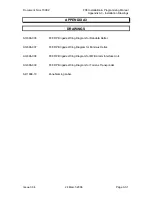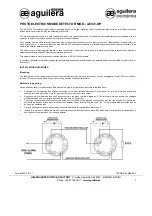
Document No: LT0082
F08 Installation & Programming Manual
Application
Considerations
5.2
FIRE
DETECTION
IN HAZARDOUS AREAS
5.2.1 REFERENCES
AS2380
Electrical Equipment for Explosive Atmospheres - Explosion Protection
Techniques.
AS 2381
Electrical Equipment for Explosive Atmospheres - Selection, Installation and
Maintenance.
AS 2430
Classification of Hazardous Areas.
IEC79
Electrical Apparatus for Explosive Atmospheres.
SAA HB13
Electrical Equipment for Hazardous Areas (Handbook).
5.2.2 GENERAL
A hazardous areas is one which has a potentially explosive atmosphere due to combustible
gases, liquids or dusts. In such an area there has to be a constraint to prevent an electrical
fault from causing as explosion.
For fire detection in hazardous areas there are two main options:
1) Use approved IS (Intrinsically Safe) detectors and bases with IS isolators or Zener
barriers and approved cabling.
2) Use approved detectors with explosion proof housings and compatible cabling.
(E.g. Olsen V41B, (V42B), V44B, T54B). These are not discussed further in this section
as the constraints are primarily mechanical.
5.2.3
INTRINSICALLY SAFE DETECTION
There are two types of device which may be inserted in a detection circuit between the FIP
and the detectors to limit the electrical energy flow into the area and provide IS detection:
1) Galvanically (transformer) isolated repeaters (isolators).
2) Zener barriers (shunt barriers with fuses). These limit the circuit voltage relative to earth,
and the circuit current.
Although Zener barriers are cheaper than isolators, they require a special Intrinsic Safety
Earth and other precautions, and are therefore not recommended.
Issue 3.04
24 March 2006
Page 5-5
Summary of Contents for F08
Page 48: ......
















































